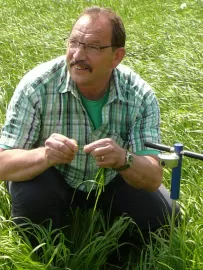
N-xt Fertilizers make your grass stronger

Grass with a good structure, healthy cattle and high-quality milk – according to cattle expert Bernard Simons in Lemelerveld those are the benefits that dairy farmers will achieve if they start using N-xt Fertilizers. “The trick is to ensure the right balance in your cattle. And ‘N-xt-gras’ will help you realise that.”
N-xt Fertilizers differ from other fertilizers in their formulations, which ensure the right balance of nutrients. “N-xt Fertilizers make phosphorus active and nitrogen less aggressive. They also contain sulphur,” he adds. “The fertilizers make your grass stronger and improve the condition of your cattle, enabling them to produce high-quality milk.”
Practical approach
Give a cow a choice of five different types of silage and she will go for the ‘N-xt silage’. Simons has seen it with his own eyes. “Cows can be very selective, and clearly prefer high-quality roughage. N-xt silage simply smells better,” says Simons, whose job is to study cows for signs of deficiencies in energy, proteins, minerals or trace elements. AgriVAK finds a practical approach most effective. “We always look at the cows first. They will tell us whether anything is wrong,” says Simons.
High-quality roughage
Sickle-shaped hocks, runny manure, a pale nose or grey withers - for Simons they are signs of a suboptimum condition in cattle. Fodder is a crucial factor. According to Simons the quality of roughage has been decreasing the past eight years. “The grass is clearly weaker. This is associated with the composition of the protein and the sugars. The building materials retain water too long, which results in poor sugar production,” explains Simons.
What’s causing this? According to Simons the problem is partly caused by today’s highly advanced means of communication. “They have resulted in different growing conditions. There’s little we can do about that, so I suggest other solutions, such as using N-xt Fertilizers.”
Better structure
As Simons says, you get all the proof you need by picking five stalks of grass and tearing off small parts of each. “With CAN grass you’ll be able to do that six or seven times. With N-xt grass only two or three times,” he says. “That shows it has a much better structure. It’s clear to me: the days of CAN fertilizers are over.” Simons is also convinced that ‘N-xt milk’ is of a better quality than ‘CAN milk’. “Ordinary milk is less resistant to the effects of microwaves. That leads to deformed nutrients. You see this less with N-xt milk.”








